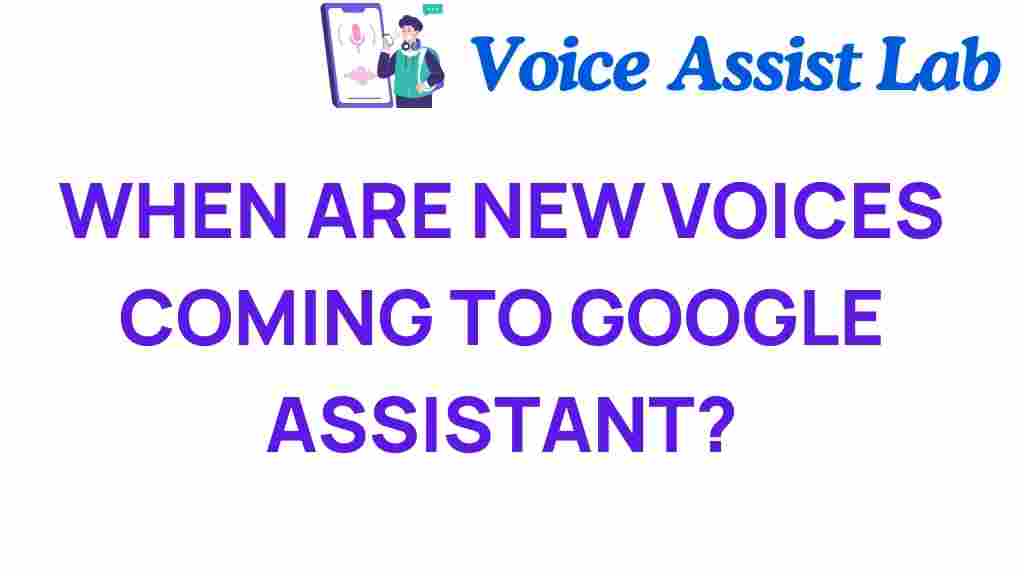Google Assistant: New Voices on the Horizon
The evolution of digital assistants has been nothing short of remarkable over the past few years. Google Assistant, a leader in the realm of voice recognition technology, has continually pushed the boundaries of innovation to enhance user experience. As users increasingly rely on these voice-activated technologies, the demand for new voices that reflect a diverse range of accents, tones, and languages has become more prominent. This article delves into the future of Google Assistant, exploring when new voices will arrive, the technology behind them, and how they will improve the overall interaction between users and their digital companions.
The Importance of New Voices
As the landscape of artificial intelligence (AI) and voice recognition evolves, the significance of incorporating new voices into Google Assistant cannot be overstated. Here’s why:
- Diversity and Inclusion: Different voices can resonate with various users, making them feel more comfortable and understood.
- Enhanced User Experience: New voices can provide a more engaging and relatable interaction, making technology feel more human.
- Improved Accessibility: Users with different speech patterns or those who speak diverse languages will benefit from tailored voice options.
The Technology Behind Google Assistant’s Voices
Understanding the technology that powers Google Assistant’s voice recognition is crucial in predicting when new voices will arrive. Google employs advanced machine learning algorithms and neural networks to generate realistic speech patterns. This technology allows for:
- Natural Language Processing (NLP): Enhances the Assistant’s ability to understand and respond to varied user inquiries.
- Text-to-Speech (TTS): Converts written text into spoken word, enabling the Assistant to deliver responses in a lifelike manner.
- Voice Cloning: This innovative process involves the creation of new voice profiles that can mimic specific speech characteristics.
Updates and Innovations
Google is known for its continuous updates and innovations in the realm of AI. The introduction of new voices is often a part of a broader update that enhances the overall functionality of Google Assistant. Users can expect:
- Regularly Scheduled Updates: Google routinely rolls out updates that may include new voices as part of their commitment to improving user experience.
- Beta Testing Programs: Users may have the opportunity to test new voices before they are officially released, providing feedback to Google.
- Integration with Other Services: As Google Assistant integrates with more devices and services, the voices will also diversify to cater to different contexts.
When Will New Voices Arrive?
The question on everyone’s mind is: when can we expect new voices for Google Assistant? While Google has not provided a specific timeline, several indicators suggest that updates are on the way:
- Recent Announcements: Google has hinted at expanding their voice offerings during major tech conferences.
- User Feedback: Increased demand from users for more diverse voice options could compel Google to accelerate their development process.
- Competition: Other digital assistants are also enhancing their voice options, which may push Google to innovate faster.
How to Prepare for New Voice Features
While waiting for the new voices to be released, users can take certain steps to ensure they are ready to enjoy the enhanced features:
- Keep Devices Updated: Ensure that your devices are running the latest version of Google Assistant to receive new features as soon as they are available.
- Explore Voice Settings: Familiarize yourself with the current voice settings in the Assistant app. This will help you easily switch to new voices when they arrive.
- Join Beta Programs: If available, join Google’s beta testing programs to get early access to new features, including voices.
Troubleshooting Voice Recognition Issues
As with any technology, users may encounter issues with voice recognition on Google Assistant. Here are some common problems and troubleshooting tips:
- Voice Not Recognized: Ensure that the microphone is not obstructed and that you are speaking clearly. Adjust your device’s sensitivity settings if necessary.
- Improper Responses: If Google Assistant frequently misunderstands commands, retrain the voice model in the app settings to help it better recognize your voice.
- Connectivity Issues: Ensure your device is connected to the internet, as a stable connection is crucial for optimal performance.
Tips for an Enhanced User Experience
To maximize your experience with Google Assistant, consider the following tips:
- Customize Routines: Set up personalized routines that integrate multiple commands into a single voice prompt.
- Use Voice Match: Enable Voice Match to allow Google Assistant to recognize individual voices and provide personalized responses.
- Explore Third-Party Integrations: Leverage various apps and services that work seamlessly with Google Assistant for a more comprehensive experience.
The Future of Digital Assistants
The introduction of new voices into Google Assistant is just one aspect of the broader evolution of digital assistants. As technology continues to advance, we can anticipate several exciting trends:
- Increased Personalization: Future updates will likely focus on tailoring experiences to individual users based on their preferences and behaviors.
- Enhanced Contextual Understanding: AI will become better at understanding context, allowing for more fluid and natural conversations.
- Broader Language Support: Expanding language options to cater to a global audience will be a priority for Google.
Conclusion: A Bright Future Ahead
As we look forward to the arrival of new voices for Google Assistant, it is clear that the future of digital assistants is bright. With advancements in technology and a commitment to improving user experience, Google is poised to lead the way in voice recognition and AI innovation. By staying informed about updates and actively participating in the evolution of these technologies, users can enjoy an enriched interaction with their digital assistants.
To learn more about the latest updates in voice recognition and AI technology, check out this comprehensive guide. For further insights into Google Assistant and its features, visit Google’s official page for the most up-to-date information.
This article is in the category Innovations and created by VoiceAssistLab Team

1 thought on “Unveiling the Future: When Will New Voices Arrive for Google Assistant?”